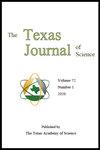WILDLIFE BEHAVIOR AT CULVERTS IN EAST TEXAS
Q4 Agricultural and Biological Sciences
引用次数: 0
Abstract
Supplemental material is available for this note online. ––––––––––––––––––––––––– Roadways are frequently associated with negative effects on wildlife, including direct effects such as vehicular fatalities, barriers to transit, removal of vegetation, habitat loss, edge effects, and corridor effects (e.g., Bennet 1991; Seiler 2003; Coffin 2007; Fahrig & Rytwinski 2009; Chen & Koprowski 2019), as well as indirect effects such as vehicle noise and artificial light (Goodwin & Shriver 2011; Shannon et al. 2014; Bliss-Ketchum et al. 2016; Troïanowski et al. 2017). Yet, many species of wildlife occur along roadways (Fahrig & Rytwinski 2009; Sparks & Gates 2012) as roadways can provide some positive benefits. For example, vegetation along roadways can provide refuges (e.g., Ruiz-Capillas et al. 2013) and can support a diversity of small mammals (e.g., Gonzalez-Olimon et al. 2016). Roadways can provide foraging and scavenging substrates and use of structures along roadways such as powerlines and poles provide perches for hunting for birds (Morelli et al. 2014).得克萨斯州东部涵洞的野生动物行为
本说明的补充材料可在线获取道路经常与对野生动物的负面影响有关,包括直接影响,如车辆死亡、交通障碍、植被移除、栖息地丧失、边缘效应和走廊效应(例如,Bennet 1991;Seiler 2003;Coffin 2007;Fahrig和Rytwinski 2009;Chen和Koprowski 2019),以及间接影响,如车辆噪音和人造光(Goodwin&Shriver 2011;Shannon等人2014;Bliss-Ketchum等人2016;Troïanowski等人2017)。然而,许多野生动物物种出现在道路上(Fahrig&Rytwinski,2009年;Sparks&Gates,2012年),因为道路可以带来一些积极的好处。例如,道路沿线的植被可以提供避难所(例如,Ruiz Capillas等人,2013),并可以支持小型哺乳动物的多样性(例如,Gonzalez-Olimon等人,2016)。道路可以提供觅食和觅食的基质,使用电力线和电线杆等道路沿线的结构可以为鸟类狩猎提供栖息处(Morelli等人,2014)。
本文章由计算机程序翻译,如有差异,请以英文原文为准。
求助全文
约1分钟内获得全文
求助全文
来源期刊

The Texas Journal of Science
Agricultural and Biological Sciences-Ecology, Evolution, Behavior and Systematics
CiteScore
0.50
自引率
0.00%
发文量
2
期刊介绍:
Scholarly manuscripts reporting original research results in any field of science or technology, including science education, will be considered for publication in The Texas Journal of Science. Prior to acceptance, each manuscript will be reviewed by both knowledgeable peers and the editorial staff. Authors are encouraged to suggest the names and addresses of two potential reviewers to the Manuscript Editor at the time of submission of their manuscript.
 求助内容:
求助内容: 应助结果提醒方式:
应助结果提醒方式:


